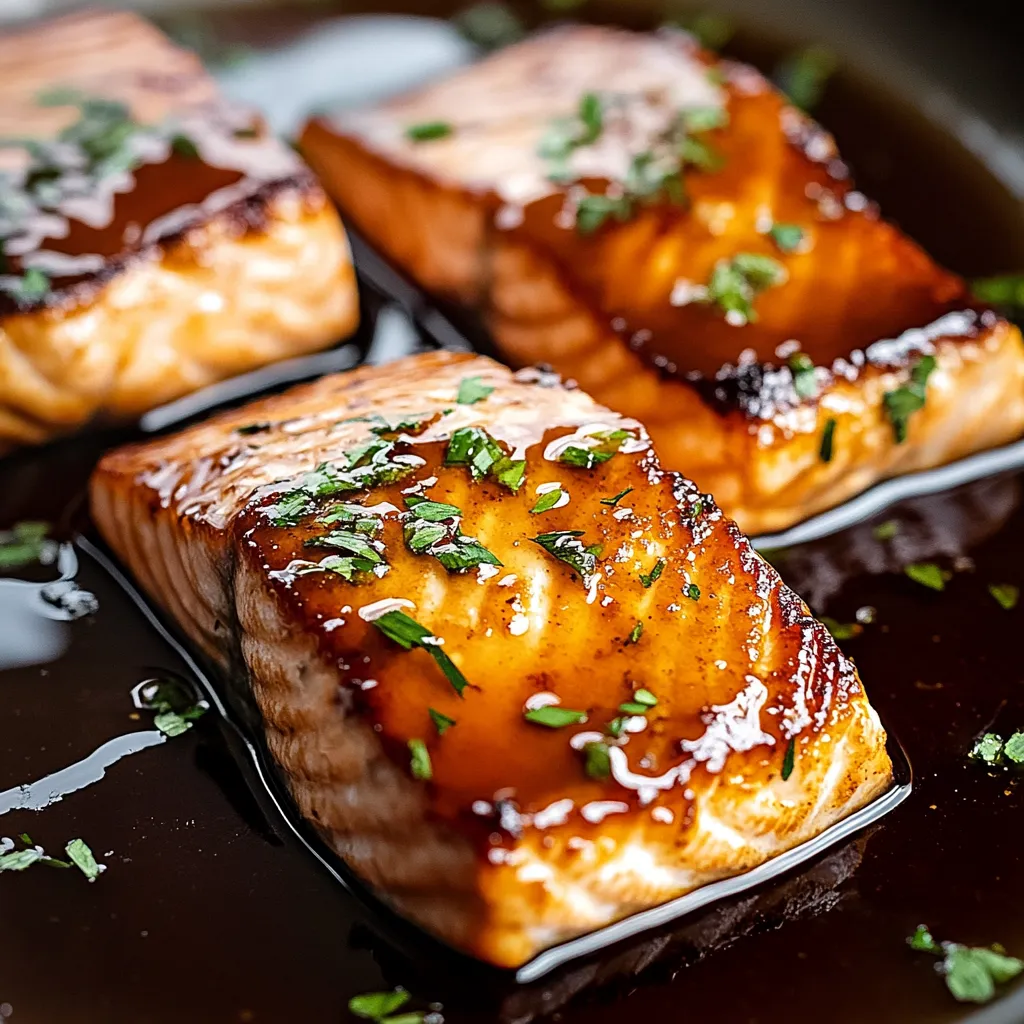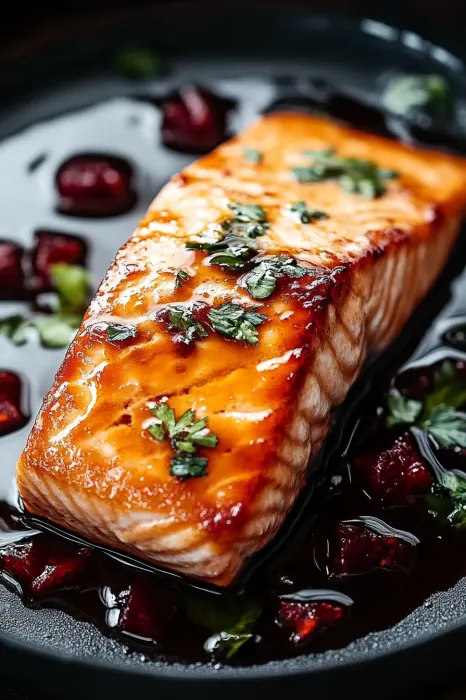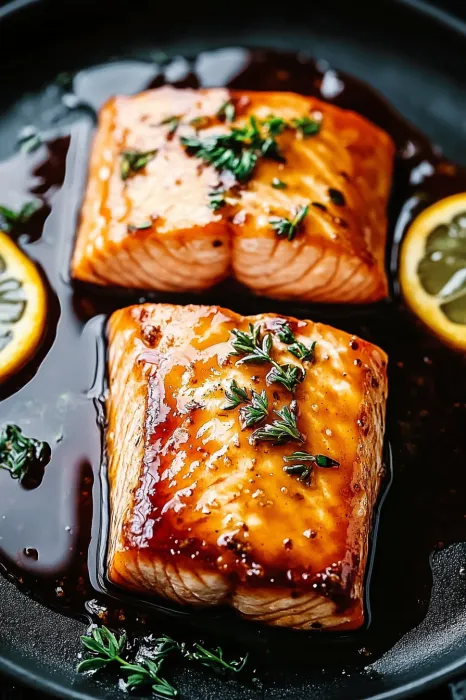 Pin it
Pin it
This brown sugar glazed salmon has become my weeknight dinner superhero, saving me from uninspired meals with its perfect balance of sweet and savory flavors. The caramelized glaze creates a beautiful crust while keeping the salmon incredibly moist and tender inside.
I discovered this recipe during a particularly hectic work week when I needed something impressive but effortless. My family was so captivated by the glossy glaze and bold flavors that it's now in our regular dinner rotation, requested at least twice a month.
Ingredients
- Fresh salmon fillets: Cut into equal pieces. Choose center cut pieces with bright color and firm texture for best results
- Brown sugar: Creates the caramelized glaze and balances the savory elements
- Soy sauce: Adds umami depth and saltiness that complements the sweetness
- Garlic powder: Infuses aromatic flavor throughout the glaze without burning like fresh garlic might
- Lemon juice: Brightens the entire dish and cuts through the richness of the salmon
- Fresh ginger: Adds a warming spicy note that pairs beautifully with the sweet elements
- Worcestershire sauce: Brings complex savory notes and depth to the glaze
- Chicken broth: Thins the sauce to perfect consistency
- Cornstarch: Creates that luxurious thick glaze that clings to the salmon
- Butter: Adds richness and helps create the perfect sear
- Olive oil: Prevents the butter from burning during the high heat cooking phase
Step-by-Step Instructions
- Room Temperature Preparation:
- Allow salmon to rest outside the refrigerator for 15-20 minutes. This crucial step ensures even cooking from edge to center. While waiting, gather and measure all sauce ingredients so everything is ready when needed.
- Salmon Preparation:
- Pat the salmon completely dry with paper towels. This removes excess moisture which is absolutely essential for achieving that golden crust. Season both sides generously with salt and pepper, pressing the seasonings gently into the flesh.
- Sauce Creation:
- Whisk together brown sugar, soy sauce, garlic powder, lemon juice, grated ginger, Worcestershire sauce, chicken broth and cornstarch until completely smooth with no lumps. The cornstarch must be fully incorporated now to prevent lumps in the final glaze.
- Perfect Searing:
- Heat your skillet until it's properly hot before adding fats. Add olive oil and butter, waiting until butter is fully melted and bubbling subsides. Place salmon skin-side down, pressing gently with a spatula for the first 10 seconds to prevent curling. Allow to cook undisturbed for 5 minutes until skin is crispy and golden.
- Flipping Technique:
- Reduce heat to prevent burning, then carefully slide a thin spatula between skin and pan, lifting and flipping in one confident motion. The flesh should release easily if properly seared. Cook for just 2-3 minutes on this side, being careful not to overcook.
- Glazing Process:
- Add remaining butter, allowing it to melt completely before adding sauce. Pour sauce around the salmon, not directly on top to preserve the sear. Watch as sauce bubbles and thickens, which happens quickly in about 20-30 seconds. Remove from heat immediately to prevent over-reducing.
- Final Flavor Infusion:
- Gently flip salmon one final time, then spoon the thickened glaze generously over each piece. The hot glaze will continue cooking the salmon slightly and penetrate the flesh with flavor.
 Pin it
Pin it
The brown sugar in this recipe creates the most magnificent caramelization that reminds me of my grandmother's special occasion dinners. She always said the secret to good salmon was treating it gently but seasoning it boldly, and this recipe honors her cooking philosophy perfectly.
Selecting the Best Salmon
Wild-caught salmon typically offers superior flavor and nutrition compared to farmed varieties. Look for Sockeye or King salmon for the richest flavor and vibrant color. The flesh should be bright, moist-looking but not slimy, and should spring back when gently pressed. Fresh salmon should never smell fishy but rather have a clean, oceanic scent. If using frozen salmon, thaw slowly in the refrigerator overnight rather than using quick-thaw methods for the best texture.
Preventing Overcooked Salmon
The most common mistake with salmon is overcooking, which results in dry, tough fish. Salmon continues cooking after being removed from heat, so take it off the heat when it reaches 125°F internal temperature for medium-rare or 130°F for medium. The center should be slightly translucent but will continue cooking in the residual heat. Remember that thinner tail pieces cook faster than thicker portions, so consider cutting your salmon into pieces of equal thickness rather than equal weight.
Perfect Pairing Suggestions
This glazed salmon creates a beautiful meal when served with jasmine rice or coconut rice that can soak up the extra glaze. For vegetables, consider quick-sautéed bok choy, steamed broccoli, or a simple cucumber salad with rice vinegar dressing to cut through the richness. A chilled Riesling or Pinot Gris complements the sweet-savory flavors perfectly. For a complete dinner party menu, start with a light miso soup and finish with fresh berries and whipped cream for dessert.
 Pin it
Pin it
Frequently Asked Questions
- → How do I prevent the salmon from sticking to the pan?
Make sure to preheat the skillet and use enough oil or butter. Pat the salmon dry and avoid overcrowding the pan for even cooking.
- → Can I use frozen salmon for this recipe?
Yes, but thaw the salmon completely and pat it dry before seasoning and cooking to ensure even searing and proper glaze absorption.
- → What can I substitute for Worcestershire sauce?
You can replace Worcestershire sauce with a mix of soy sauce and a small amount of vinegar for a similar depth of flavor.
- → How do I adjust the sweetness in the glaze?
Reduce the brown sugar slightly or add a bit more lemon juice to balance the sweetness with acidity.
- → Can I use other types of fish with this glaze?
Yes, this glaze works well with other fish like cod, trout, or halibut. Adjust cooking times based on the thickness of the fillet.
